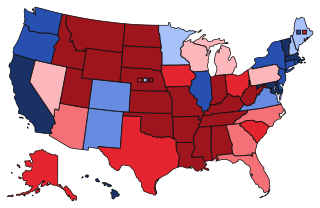
Back Cook Partisan Voting Index German Cook Partisan Voting Index English Cook Partisan Voting Index French Cook Partisan Voting Index Hungarian クック党派投票指数 Japanese 쿡 당파 투표 지수 Korean Cook Partisan Voting Index Dutch Рейтинг партийного голосования (США) Russian Cook Partisan Voting Index SIMPLE Chỉ số bầu cử đảng phái của Cook Vietnamese

Il Cook Partisan Voting Index, abbreviato in PVI o CPVI, è un sistema di misurazione di quanto i distretti congressuali o gli stati tendano verso uno dei due principali partiti politici.[1] Questo indice di parte[2] viene indicato come la tendenza verso il Partito Repubblicano o il Partito Democratico, rispetto alla tendenza della nazione nella sua interezza, basandosi su come quel distretto o stato ha votato nelle due precedenti elezioni presidenziali.[3][4]
- ^ Paul, M., Zhang, R., Liu, B. et al. State-level political partisanship strongly correlates with health outcomes for US children. Eur J Pediatr 181, 273–280 (2022).
- ^ Chris Cillizza, A map that shows we really do live in two different Americas, su edition.cnn.com, CNN, 10 aprile 2017. URL consultato il 24 dicembre 2023.
- ^ Chris Cillizza, The differences between real grassroots and "Astroturf" matter, su cnn.com, CNN, 14 marzo 2018. URL consultato il 24 dicembre 2023.«Which brings me to the Cook Political Report's Partisan Voting Index or PVI. The goal of the PVI is to compare every congressional district to every other congressional district based on how it has performed in each of the last two presidential elections.»
- ^ Steve Benen, There are 119 Republican House members who should be VERY nervous today, su cnn.com, MSNBC, 7 febbraio 2017. URL consultato il 24 dicembre 2023.«To get a sense of a congressional district's political leanings, there's a helpful metric called the Partisan Voter Index, or PVI, created 20 years ago by the Cook Political Report.»